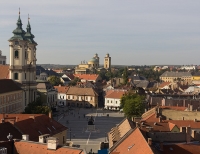
For many Hungarians, the name of Eger represents the story of brave patriotism in the face of immense danger. Led by István Dobó, heroic soldiers of the fortress held out against an attack by the Turks in 1552. Sculptures representing the battle against the Turks are a proud reminder of the victorious saga.
Eger is a paradise for historical sightseers and contains something like 200 historical monuments. It is picturesque, with a small pedestrianised town centre featuring brightly-painted houses with iron balconies lining narrow twisting streets. Ornate lampposts and hanging baskets of flowers decorate the cobbled lanes and squares.
Eger sits at the centre of the wine-growing region of northern Hungary. This enchanting town, along with its famous history, is where the much-publicised Egri Bikavér, or Bull's Blood, has its origins. It is the strong and spicy red wine that is characteristic of the area.
Wine growing has been part of its history since the 11th century, started by the monks and continued during the Turkish occupation as an important source of income for the Turks. Wines can be tasted in the centuries-old wine cellars of the Szépasszony Valley (Valley of the Pretty Woman) on the southern edge of town.
Eger is a colourful town known not only for its history, mellow charm, and vineyards, but also for its thermal baths. Visitors looking for a bit of time-out can unwind in the peaceful Archbishop's Garden, a leafy park enclosing swimming pools and hot Turkish baths.

Travel Guide powered by Word Travels, copyright © 2023 Globe Media Ltd. By its very nature information in this travel guide is subject to change at short notice and travellers are urged to verify information on which they're relying with the relevant authorities. Neither Globe Media Ltd nor Travel Vogue can accept any responsibility for any loss or inconvenience to any person as a result of information contained above.